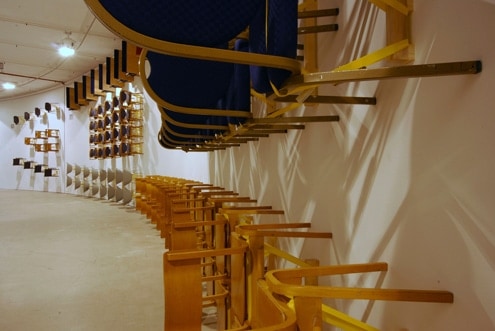
The Barbican Centre juts and squats over the East London real-estate goldmine like the castle of a mad king. As with other late-‘60s Brutalist buildings in London, the Barbican’s reputation has swung from lauded to loathed to begrudgingly loved, with the potted plants on its cantilevered balconies now standing as white flags over the parapet. The Barbican is both Europe’s largest performing arts center and “London’s ugliest building,” according to a 2003 poll.
Now, this apparent contradiction is the subject of a quixotic exploration of the nature of public space by the Austrian artist Hans Schabus. For his installation in the Barbican’s Curve gallery, titled Next Time I’m Here, I’ll Be There, Schabus has attached 461 chairs to the wall of the crescent-shaped space, chairs that he culled from Barbican offices, meeting rooms, cafes and theaters and arranged them according to the seating plan of a jumbo jet.
The Curve gallery is an 80-meter-long, gently arcing space originally designed as a sound buffer for the auditorium behind. Its awkward shape, incomprehensible as a whole and too narrow to provide much viewing space for wall-mounted artworks, can drown out certain displays. Schabus, well used to generating awkwardness in architectural space (his 2003 installation,Astronaut (Be Right Back), at Vienna’s Secession, blocked the usual entrance and sent visitors through the underbelly of the building via a series of narrow alleyways), has engaged with this intrinsic challenge, finding in its odd curl a very close reflection (within a few feet in both height and length) of the dimensions of a huge passenger plane. A serendipitous coincidence has become a metaphor of certain kinds of organization that reflects on the modernist utopia of the building itself.
The printed extension of Schabus’ installation, a series of large collages that the artist refers to as “drawing boards,” bears out the whimsically chanced-upon arrangement. Superimpositions of the floor plan of the Curve’s wall on photographs of a dam and the ferris wheel in Vienna, while appealingly weird in their thinking, undermine the integrity of the finished installation, whose conceit is already built on slim foundations. A series of speakers spaced along the inside wall apparently connect to microphones scattered within the Barbican complex, which means that the sound of a sliding elevator door is occasionally audible, quite quietly. The sound doesn’t quite puncture the impact of the sweeping wall of chairs, but it does render the interlocked concept and esthetic of the main installation that much more successful.
The installation of the chairs — organized into a naive taxonomy of like colors and designs, their feet lashed by yellow straps into wooden brackets on the wall — has the disquieting effect of a world encountered in zero gravity. The apparent endlessness of the curved wall underscores this impression, suggesting a vast empty spaceship turning in space, its pedantically organized seating suddenly somehow sad.
Initially, the mind attempts to relocate each object according to its implied position within the institution, branching out into a mental map that positions each chair in its place of origin in a kind of imaginary baggage-reclaim. Those leather-backed padded chairs with their spider-web cracks must be from a meeting-room; those battered red plastic chairs (one inscribed “park your bum here” in marker) must have sat outside in the cafe; those slatted modernist wooden ones almost certainly from the director’s office (they turn out to be from the chamber of the head of exhibitions).
Schabus’ installation is, then, a re-mapping of institutional space, but without the arid theorizing that academic description implies. Schabus’ accumulation of objects is down to earth, and specifically speaks to the relationship of the human body to architectural space. The body goes against the wipe-clean perfection of the modernist ethos, here symbolized by the architecture that has created this functional spatial anomaly. The pathos (and humor) of modernist architectural projections (Schabus’ collages recall impossible blueprints) is their flawless surfaces, as-yet-unsullied by human touch. Each chair implies a human presence, not just in its language of parts (seat, back, legs, arms, feet) but also in its implication of human inactivity.
In this way, the airplane analogy seems not chancy but conceptually of a piece with Schabus’ ongoing exploration of the breach between an artistic dream, held in the head, and human reality, worn down by the union of gravity and time. Chair design always implies a defined temporal as well as physical space. It’s time you think about here, the eat-and-leave comfortlessness of the café chairs, the sit-up-straight right angles of the office chairs, made for a nine-to-five life. And, of course, the implied time of transatlantic flight, the ultimate metaphor for modern temporal and spatial organization.
In today’s climate, it’s perhaps not surprising that the conflation of modern architecture and large passenger aircraft should provoke a sense of disquiet. But that kind of sociopolitical anxiety is probably not Schabus’ intention here. Rather, he has lighted upon an elegant esthetic contradiction that does what all good art should do: flies out beyond the gallery and illuminates the ordinary with pools of thought, like lights.
- Originally published on Artnet.
- Hans Schabus, "Next Time I’m Here, I’ll Be There", 1 March - 1 June, 2008, at Curve Gallery, Barbican Art Gallery, London.